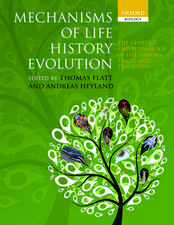The Macaque Connection: Cooperation and Conflict between Humans and Macaques: Developments in Primatology: Progress and Prospects, cartea 43
Editat de Sindhu Radhakrishna, Michael A. Huffman, Anindya Sinhaen Limba Engleză Hardback – 27 aug 2012
| Toate formatele și edițiile | Preț | Express |
|---|---|---|
| Paperback (1) | 943.25 lei 6-8 săpt. | |
| Springer – 20 sep 2014 | 943.25 lei 6-8 săpt. | |
| Hardback (1) | 947.85 lei 6-8 săpt. | |
| Springer – 27 aug 2012 | 947.85 lei 6-8 săpt. |
Din seria Developments in Primatology: Progress and Prospects
- 20%
 Preț: 571.31 lei
Preț: 571.31 lei - 18%
 Preț: 1216.65 lei
Preț: 1216.65 lei - 19%
 Preț: 578.66 lei
Preț: 578.66 lei - 18%
 Preț: 956.69 lei
Preț: 956.69 lei - 18%
 Preț: 948.92 lei
Preț: 948.92 lei - 18%
 Preț: 948.92 lei
Preț: 948.92 lei - 18%
 Preț: 945.79 lei
Preț: 945.79 lei - 18%
 Preț: 962.66 lei
Preț: 962.66 lei - 18%
 Preț: 1664.43 lei
Preț: 1664.43 lei - 18%
 Preț: 1224.54 lei
Preț: 1224.54 lei - 24%
 Preț: 826.25 lei
Preț: 826.25 lei - 24%
 Preț: 802.74 lei
Preț: 802.74 lei - 18%
 Preț: 1562.94 lei
Preț: 1562.94 lei - 18%
 Preț: 950.21 lei
Preț: 950.21 lei - 18%
 Preț: 943.73 lei
Preț: 943.73 lei - 18%
 Preț: 1549.67 lei
Preț: 1549.67 lei - 18%
 Preț: 1248.20 lei
Preț: 1248.20 lei - 18%
 Preț: 941.38 lei
Preț: 941.38 lei - 24%
 Preț: 800.85 lei
Preț: 800.85 lei - 18%
 Preț: 953.35 lei
Preț: 953.35 lei - 18%
 Preț: 1827.48 lei
Preț: 1827.48 lei - 18%
 Preț: 1214.90 lei
Preț: 1214.90 lei - 18%
 Preț: 957.62 lei
Preț: 957.62 lei - 18%
 Preț: 1231.47 lei
Preț: 1231.47 lei - 18%
 Preț: 1225.48 lei
Preț: 1225.48 lei - 5%
 Preț: 1433.83 lei
Preț: 1433.83 lei - 18%
 Preț: 1231.16 lei
Preț: 1231.16 lei - 18%
 Preț: 1226.90 lei
Preț: 1226.90 lei - 18%
 Preț: 955.25 lei
Preț: 955.25 lei - 18%
 Preț: 956.03 lei
Preț: 956.03 lei - 18%
 Preț: 1218.53 lei
Preț: 1218.53 lei - 18%
 Preț: 950.52 lei
Preț: 950.52 lei -
 Preț: 416.82 lei
Preț: 416.82 lei - 18%
 Preț: 1554.89 lei
Preț: 1554.89 lei
Preț: 947.85 lei
Preț vechi: 1155.91 lei
-18% Nou
Puncte Express: 1422
Preț estimativ în valută:
181.42€ • 186.96$ • 153.16£
181.42€ • 186.96$ • 153.16£
Carte tipărită la comandă
Livrare economică 01-15 martie
Preluare comenzi: 021 569.72.76
Specificații
ISBN-13: 9781461439660
ISBN-10: 1461439663
Pagini: 268
Ilustrații: XII, 256 p.
Dimensiuni: 155 x 235 x 20 mm
Greutate: 0.51 kg
Ediția:2013
Editura: Springer
Colecția Springer
Seria Developments in Primatology: Progress and Prospects
Locul publicării:New York, NY, United States
ISBN-10: 1461439663
Pagini: 268
Ilustrații: XII, 256 p.
Dimensiuni: 155 x 235 x 20 mm
Greutate: 0.51 kg
Ediția:2013
Editura: Springer
Colecția Springer
Seria Developments in Primatology: Progress and Prospects
Locul publicării:New York, NY, United States
Public țintă
GraduateCuprins
CONTENTS
PREFACE
iii
CONTRIBUTORS
viii
PART I: INTRODUCTION
1
3
PART II: TRADITIONAL VIEWS OF MACAQUES
30
32
3. The Japanese and Japanese Monkeys: Dissonant Neighbors Seeking Accommodation in aShared Habitat
Yoshihisa Mito and David Sprague
53
80
PART III: COOPERATIVE RELATIONSHIPS BETWEEN HUMANS AND MACAQUES
112
114
154
180
PART IV: CURRENT SCENARIOS OF HUMAN-MACAQUE CONFLICT
212
Translated from Kannada by Honnavalli N Kumara and Shantala Kumar
214
227
251
286
PART V: HOW LIVING WITH AND BESIDE HUMANS HAS AFFECTED MACAQUES
317
319
358
391
INDEX
PREFACE
iii
CONTRIBUTORS
viii
PART I: INTRODUCTION
1
- The Gulf between Monkeys and Men
3
PART II: TRADITIONAL VIEWS OF MACAQUES
30
- The Nature of Love
32
3. The Japanese and Japanese Monkeys: Dissonant Neighbors Seeking Accommodation in aShared Habitat
Yoshihisa Mito and David Sprague
53
- Songs of Monkeys: Representations of Macaques in Classical Tamil Poetry
80
PART III: COOPERATIVE RELATIONSHIPS BETWEEN HUMANS AND MACAQUES
112
- Macaques and Biomedicine: Notes on Decolonization, Polio, and Changing Representations of Indian Rhesus in the United States, 1930-1960
114
- Macaque Tourism: Implications for their Management and Conservation
154
- Pets, Property, and Partners: Macaques as Commodities in the Human-Other PrimateInterface
180
PART IV: CURRENT SCENARIOS OF HUMAN-MACAQUE CONFLICT
212
- Gaadli
Translated from Kannada by Honnavalli N Kumara and Shantala Kumar
214
- Macaque-Human Interactions in Past and Present-Day Sri Lanka
227
- Monyet Yang Dihargai, Monyet Yang Dibenci: The Human-Macaque Interface in Indonesia
251
- Out of Asia: The Curious Case of the Barbary Macaque
286
PART V: HOW LIVING WITH AND BESIDE HUMANS HAS AFFECTED MACAQUES
317
- The Monkey in the Town’s Commons, Revisited: An Anthropogenic History of the Indian Bonnet Macaque
319
- Genetic Consequences of Anthropogenic Effects on Macaques
358
- Managing Humans, Managing Macaques: Human-Macaque Conflict in Asia and Africa
391
INDEX
Recenzii
From the reviews:
“This book focuses on macaques, the most widely distributed and behaviorally flexible nonhuman primate species. … a useful, timely collection of essays highlighting the diversity of the genus and its interface with humans. Summing Up: Recommended. Upper-division undergraduates through professionals.” (L. Swedell, Choice, Vol. 50 (8), April, 2013)
“The Macaque Connection … explores the many ways in which humans and macaques have connected in the past and the present. … The Macaque Connection focuses on providing a rich historical perspective on a wider range of macaque species. The Macaque Connection therefore has greater relevance for historians and cultural anthropologists. … of interest to primatologists––especially macaque researchers.” (Crystal M. Riley, International Journal of Primatology, Vol. 34, 2013)
“This book focuses on macaques, the most widely distributed and behaviorally flexible nonhuman primate species. … a useful, timely collection of essays highlighting the diversity of the genus and its interface with humans. Summing Up: Recommended. Upper-division undergraduates through professionals.” (L. Swedell, Choice, Vol. 50 (8), April, 2013)
“The Macaque Connection … explores the many ways in which humans and macaques have connected in the past and the present. … The Macaque Connection focuses on providing a rich historical perspective on a wider range of macaque species. The Macaque Connection therefore has greater relevance for historians and cultural anthropologists. … of interest to primatologists––especially macaque researchers.” (Crystal M. Riley, International Journal of Primatology, Vol. 34, 2013)
Textul de pe ultima copertă
Most successful among the non-human primates in terms of geographical distribution and adaptability to ecological habitats, macaques have existed for many thousands of years in close contact with modern humans, the only primate more successful than them. Centuries-old literary works attest to the fact that macaques have always been an intrinsic part of human lives and imaginations. In their interactions with humans, macaques play multiple roles that often transcend the boundaries of categorization. They are often, simultaneously, wildlife and domestic pets, sentient beings and experimental subjects, crop-raiding pests and religious symbols. In many parts of the tropics, macaques are an economic resource for human communities, as they provide meat and money through tourism and the animal trade. Equally, they cause much damage and bring about great economic losses due to their crop- and house-raiding tendencies. A more recent cause for alarm has been the possibility of transmission of diseases to humans due to contact with macaques. Across Asia, macaques, perhaps more than any other animal species, exemplify the multiple facets of synurbization and the conservation problems of commensal species.
Humans and macaques associate in rather remarkable ways, and this volume explores the tone and nature of those human-macaque connections by focusing on various forms of interactions between macaques and humans, change in human attitudes vis-à-vis macaques over the ages, cultural views on macaques, human-macaque conflict and its conservation implications. Its holistic perspective of the myriad aspects that illustrate the singular relationship between men and macaques makes it essential reading not only for primatologists and anthropologists but also for anyone interested in the intricacies of human-animal relations.
Humans and macaques associate in rather remarkable ways, and this volume explores the tone and nature of those human-macaque connections by focusing on various forms of interactions between macaques and humans, change in human attitudes vis-à-vis macaques over the ages, cultural views on macaques, human-macaque conflict and its conservation implications. Its holistic perspective of the myriad aspects that illustrate the singular relationship between men and macaques makes it essential reading not only for primatologists and anthropologists but also for anyone interested in the intricacies of human-animal relations.
Caracteristici
Details cooperative relationships between humans and macaques Describes current scenarios of human-macaque conflict Highlights traditional views of macaques?











